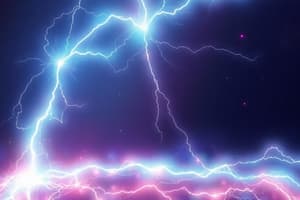Podcast
Questions and Answers
What creates an electric current?
What creates an electric current?
The movement of electrons from one atom to another creates an electric current.
What is the unit used to measure electric current?
What is the unit used to measure electric current?
Ampere (A)
What causes charges to move in a closed circuit?
What causes charges to move in a closed circuit?
- Electric Field
- Resistance
- Current
- Voltage (correct)
What does the voltmeter measure?
What does the voltmeter measure?
What is the formula for calculating current?
What is the formula for calculating current?
What symbol represents voltage?
What symbol represents voltage?
What is the resistance measured in?
What is the resistance measured in?
Electricity is generated by the movement of electrons.
Electricity is generated by the movement of electrons.
How does electricity affect our daily lives?
How does electricity affect our daily lives?
Flashcards are hidden until you start studying
Study Notes
Electricity Overview
- Electricity is the flow of electric charge through conductors, powering devices and machinery crucial for everyday life.
- Produced by the movement of electrons, subatomic particles found in atoms.
Key Concepts
-
Electric Current:
- Measures the number of electrical charges passing through a conductor over time.
- Symbol: I; Unit of measurement: Ampere (A).
- Electrons flow from the negative terminal to the positive terminal.
-
Voltage:
- Acts like pressure causing electric current to flow.
- Symbol: V; Unit of measurement: Volts (V), named after Alessandro Volta.
- Voltage creates an electric field that pushes electrons in a circuit.
-
Resistance:
- Represents how much a material resists the movement of electrons.
- High resistance materials (like rubber) hinder flow, while low resistance materials (like copper) allow easier current flow.
- Measured in ohms (Ω), resistance converts electrical energy into heat.
Ohm's Law
- Demonstrates the relationship between current (I), voltage (V), and resistance (R):
- Current (I) = Voltage (V) ÷ Resistance (R)
- Example calculation illustrates how to find voltage or current based on the other two variables.
Practical Applications of Electricity
- Essential for activities like watching TV, using computers, and internet connectivity.
- Transportation systems such as LRT and MRT rely on electric power.
Understanding Circuit Dynamics
- In a closed circuit, voltage from a power source (like a battery) generates an electric field, enabling current flow.
- An ammeter is used to measure electric current, while a voltmeter measures voltage across components.
Reflection on Electricity's Role
- Students are encouraged to consider the impact of electricity on daily life, including what life would be like without it.
Studying That Suits You
Use AI to generate personalized quizzes and flashcards to suit your learning preferences.




